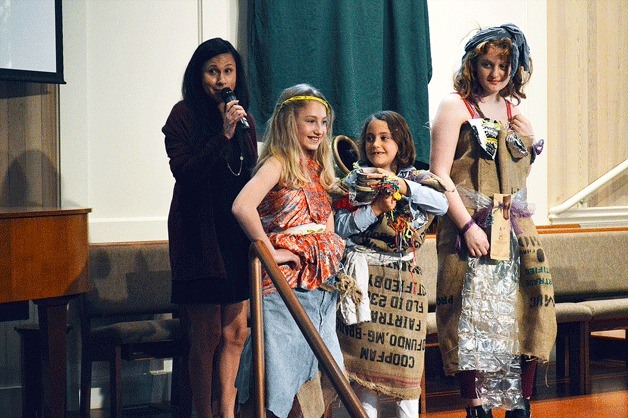During intermission, we’re fed with facts: 700 gallons of water to produce a single cotton T-shirt; 2,900 to produce a pair of jeans.
I discreetly peek to remember what’s covering my bottom half. Will these eco-people shun me and my offending outfit, which was definitely not made from trash? I panic more about public perception than I do about planet Earth; clearly, I have a lot to learn. Collectively, with my countrymen, I buy 20 billion new items of clothing every year and the next, I’m still panting for more. Gotta keep up, gotta stand out — but not here, please. Not in Eagle Harbor Congregational Church, in the middle of a Trashion Show put on by Zero Waste. I really wish I were wearing green, like the sheet someone’s shrouded the cross with.
Fortunately, no one’s staring or thinking of the unconsciously-dressed reporter.
Our eyes are all on the ensembles: Angeline just walked by in a tank top made from the pages of an elementary school reading book. Her sage skirt is a pillowcase snagged from last year’s Rotary Auction.
Roni Katz Cooper follows in a would-be leather jacket crafted from bicycle tubes, corks and thrift shop denim; upcycled jean overalls get a monster edge — eyes, jagged teeth, snout, paws — with scraps of fabric.
Three models later, we meet “Madam Secretary,” Sue VanDuine’s Betsy Johnson-esque ode to the striking African bird, whose population has been threatened by habitat loss and deforestation. The drama of shorned-magazine epaulets, a paper-spined mask: I imagine a “Black Swan”-dark ballet in which climate change overtakes.
But this is not an apocalyptic afternoon; it’s an inspirational showcase.
Back on stage, six audience members get a mystery bag and 15 minutes to assemble an outfit out of burlap, packing materials and discarded white cheddar popcorn bags — yes, it’s Zoolander’s Derelicte. They probably won’t take these looks to the street, but they can remember this creativity the next time they have a wardrobe need.
One of the best ways to reduce textile waste, Spinak said, is to swap clothes with friends or shop consignment.
“You’re cutting the impact by not demanding new materials are used,” she explained.
The really serious can try to buy less or — in the extreme — buy nothing at all.
That’s what Trashion Show emcee Rebecca Rockefeller did.
From one Rosh Hashanah to another, the Buy Nothing Project co-founder wore just one dress. Every single day, every single hour — except for swimming and sleeping — this black cotton wrap, no-sleeve V-neck dress (her Ebay search terms) got her through.
“I wanted an inexpensive, accessible garment that wasn’t particularly well-made to test things, to see how well it would hold up and whether it would drive me crazy to wear the same thing,” Rockefeller explained.
Rockefeller crowd sourced accessories using the Buy Nothing platform.
“I got bras, I got socks — the only thing I didn’t get was panties,” she said.
Of course, there were a few hiccups in the 13-month experiment.
When trips to clean the chicken coop went awry, Rockefeller had to cancel morning appointments.
“There were a couple of days where I would call people and say I can’t meet you, my dress is wet,” Rockefeller said.
That was until someone came to the rescue with a raincoat, circa 1980, velvet-cuffed and forest green.
“You would never wear it out in public, but for me it was a perfectly functional thing.”
The real test of the $7 dress was a vacation to Hawaii.
“That just about killed it,” she said of the trip. “The sun started to really bleach it out and age it quickly.”
Still, Rockefeller made it back to the mainland fully clothed, all her near-disasters successfully averted. When it came time to wrap up the experiment, over a year ago, she was sad.
“I missed it actually,” she said, adding that it eliminated much of the anxiety of getting dressed. “I loved the freedom of knowing exactly what I was going to put on and only having to choose the accessories.”
Rockefeller will attest, though, that reducing textile waste doesn’t have to mean embargoing every Nordstrom or REI in the land. The first step to buying less is shopping more thoughtfully.
Post-black dress, she tries to buy only what she needs, “and I wait until I need them twice,” she said.
The other strategy she’s picked up from her uniform days is fixing her stuff herself. “I’m not a good seamstress by any stretch of the imagination, but I’ve sort of freed myself to try it out,” she said.
Spinak echoed that advice, but also pointed out that you can always call on a professional or a friend. “Not only do these options lessen your impact on the world, they build community,” she added.
Select Trashion Show outfits are on display at the Bainbridge Public Library through the end of April.
For the full line-up and descriptions, visit www.earthartbainbridge.org/trashion-fashion.



